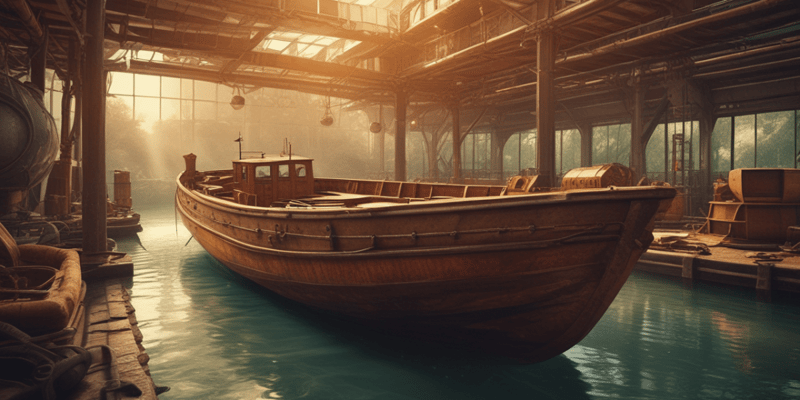24 Questions
What is a benefit of the vacuum bagging process in terms of fibre content?
Higher fibre content laminates can usually be achieved
What type of materials can be used as cores in the vacuum bagging process?
Any type of core
What is a disadvantage of the vacuum bagging process?
It adds cost both in labour and in disposable bagging materials
What is a characteristic of the filament winding process?
Fibres are used straight from a creel and not woven or stitched into a fabric form
What type of components are typically produced using the filament winding process?
Hollow, generally circular or oval sectioned components
What is an application of the filament winding process?
Chemical storage tanks and pipelines
What is an advantage of the vacuum bagging process in terms of health and safety?
It reduces the amount of volatiles emitted during cure
What is a characteristic of the resin options for the filament winding process?
Any type of resin can be used
What is an advantage of the described manufacturing process in terms of fibre cost?
Fibre cost is minimised since there is no secondary process
What is a limitation of the described manufacturing process?
The process is limited to convex shaped components
What is a characteristic of the materials used in pultrusion?
Any type of fibre can be used
What happens to the material as it passes through the die in pultrusion?
The material is cured in its final shape
What is an application of the described manufacturing process?
Beams and girders used in roof structures and bridges
What is a variation of pultrusion that allows for some variation in cross-section?
Pulforming
What type of resin is typically not used in pultrusion due to its properties?
Low viscosity resin
What is a characteristic of the external surface of a component produced by the described manufacturing process?
It is rough and unmoulded
What is the main advantage of Vacuum Bagging over Wet Lay-up?
Improved consolidation of the laminate
Which of the following materials is NOT suitable for use in laminates?
Steel
What is a disadvantage of using low-molecular-weight resins in Wet Lay-up?
Potential health risks to laminators
What is a benefit of using room-temperature cure resins in Wet Lay-up?
Lower cost tooling
What is the primary mechanism of Vacuum Bagging?
Applying pressure to the laminate using a vacuum pump
What is a common application of Wet Lay-up and Vacuum Bagging?
Standard wind-turbine blades
What is a limitation of Wet Lay-up?
Dependence on laminator skills
Why is it challenging to limit airborne styrene concentrations in Wet Lay-up?
High cost of extraction systems
Study Notes
Materials Options
- Resins: Epoxy, phenolic, polyester, and vinylester are commonly used.
- Fibres: Heavy fabrics can be wet-out due to consolidation pressures.
- Cores: Any type of core can be used.
Vacuum Bagging
- Higher fibre content laminates can be achieved compared to standard wet lay-up techniques.
- Lower void contents are achieved compared to wet lay-up.
- Better fibre wet-out due to pressure and resin flow throughout structural fibres.
- Reduces volatiles emitted during cure, improving health and safety.
Filament Winding
- Used for hollow, circular or oval sectioned components, such as pipes and tanks.
- Fibre tows are passed through a resin bath before being wound onto a mandrel.
- Materials options: Any resin, fibre, and core can be used.
- Typical applications: Chemical storage tanks, gas cylinders, and fire-fighters breathing tanks.
Advantages of Filament Winding
- Fast and economic method of laying material down.
- Resin content can be controlled by metering resin onto each fibre tow.
- Fibre cost is minimised since no secondary process is required to convert fibre into fabric.
- Structural properties of laminates can be very good.
Disadvantages of Filament Winding
- Limited to convex shaped components.
- Fibre cannot be laid exactly along the length of a component.
- Mandrel costs for large components can be high.
- External surface of the component is unmoulded and cosmetically unattractive.
- Low viscosity resins usually need to be used.
Pultrusion
- Fibres are pulled from a creel through a resin bath and then on through a heated die.
- Die completes the impregnation of the fibre, controls the resin content, and cures the material.
- Materials options: Generally epoxy, polyester, vinylester, and phenolic resins, and any type of fibre.
- Typical applications: Beams and girders used in roof structures, bridges, and ladders.
Advantages of Pultrusion
- Laminates are left to cure under standard atmospheric conditions.
- Other advantages similar to those of vacuum bagging.
Wet Lay-up
- Widely used for many years.
- Simple principles to teach.
- Low cost tooling, if room-temperature cure resins are used.
- Wide choice of suppliers and material types.
- Higher fibre contents, and longer fibres than with spray lay-up.
Disadvantages of Wet Lay-up
- Resin mixing, laminate resin contents, and laminate quality are very dependent on the skills of laminators.
- Health and safety considerations of resins.
- Limiting airborne styrene concentrations to legislated levels from polyesters and vinylesters is becoming increasingly hard.
- Resins need to be low in viscosity to be workable by hand, compromising their mechanical/thermal properties.
This quiz covers the materials used in vacuum bagging for boat building, including resins, fibers, and cores, and their applications.
Make Your Own Quizzes and Flashcards
Convert your notes into interactive study material.
Get started for free


